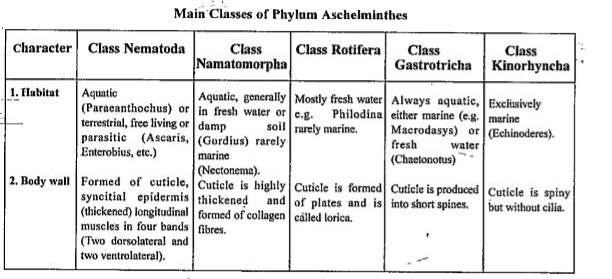Enumerate the important characters of Nemathelminthes or Aschelminthes.
Text Solution
Aschelminthes. Minute nematodes were discovered only after the invention of microscope. Linnaeus (1758) included these in "Vermes", Rudophi included these under "Nematoidea" Gegenbaur (1859), ultimately proposed "Nema thelminthes" for these.
1. Natural history. The roundworms occur everywhere—in fresh water, sea water and soil, Many live as parasites in plants and animals.
2. Body form. The body is worm-like, cylindrical, with or without division into regions. It has no segmentation.
3. Symmetry. The symmetry is bilateral.
4. Germ layers. The bagworms are triploblastic, i.e. they develop from ectoderm, mesoderm and endoderm.
5. Level of organization. The bagworms have organ-system level of organization. /
6. Head. The anterior end has no definite head.
7. Appendages. There are no appendages. Locomotion is ciliary in many groups and muscular in others.
8. Body wall. The body wall may consist of cuticle, epidermis and muscle layer: The. cuticle is moulted (changed) during growth period or throughout life. The epidermis may be syncytial or cellular.
9. Musculature. These possess antagonistic circular and longitudinal muscles acting on a hydrostatic skeleton.
10. Body cavity. A fluid filled cavity may be present between the body wall and the digestive tract. It is not lined by an epithelium. Hence, it is called the pseudocoel or false coelom. Pseudocoel is derived from blastocoel. It is, in reality, a haemocoel without heart.
11. Digestive tract. The digestive tract is said to be complete. It generally has a non-muscular wall, and its anterior and posterior parts are lined by ectodermal epithelium, forming stomodaeum and proctodaeum respectively. A specialized pharynx is almost always present. Stomach is absent.
12. Respiration. Respiration occurs by diffusion through the body surface.
13. Circulatory system. The circulatory system is undeveloped because most forms are very small in size.
14. Nervous System. The nervous system comprises a circumpharyngeal ring that sends nerves. forward as well as backward.
15. Excretory System. The excretory system consists of gland cells, or of canals, or both. Some forms have protonephridia.
16. Reproduction. Sexes are mostly separate. Fertilization is internal. There is no asexual reproduction
17. Development Cleavage is determinate Life history may be simple or complex.

|
Updated on:21/07/2023
Similar Questions
Knowledge Check
- Question 1 - Select One
An important character of platyelminthes is
AmonoeciousBVitelline glandsCFlat animalsDFlame cells - Question 2 - Select One
The important character of cobra is
APresence of hoodBSmall scales on headCRounded tailDNone of these - Question 3 - Select One
Aschelminthes are -
AFree-living, aquatic, terrestrial or parasites in animals and plantsBWith comiplete alimentary canal with muscular pharynx, Excretory tube with poreCAre dioecious, showing sexual dimorphism, internal fertilization, direct or indirect developmentDAll
The most important character of chordata is
View SolutionDescribe the important characters of kingdom plantae.
View SolutionAn important character not present in platyhelminthes is
View SolutionMost important character of all sponges :
View SolutionThe most important character of chordata is
View Solution

